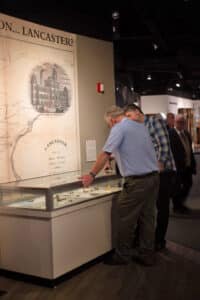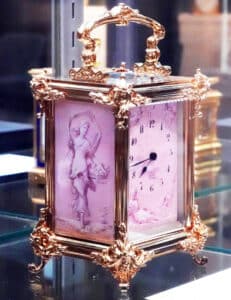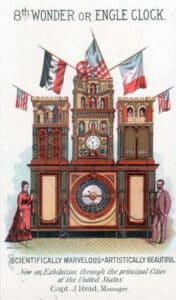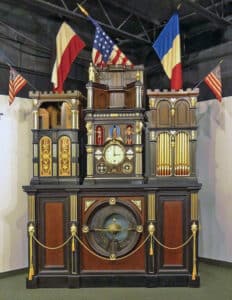The National Association of Watch & Clock Collectors, Inc. (NAWCC) formed in 1943 when three watch collectors formed the organization then called The Watch Collectors Club. Once they added “Collectors” to the name, its membership grew exponentially and today boasts over 10,000 members worldwide. They are committed to “being the world leader, educator, and advocate for horology and for everyone interested in timepieces and the art and science of timekeeping” according to their website, www.nawcc.org. To that end, they created the National Watch and Clock Museum in Columbia, Pennsylvania.
The Museum houses the largest collection of international timepieces in North America. Along with the collection, they maintain the largest horological research library, offer workshops, conduct symposiums, meetings, annual conventions, and more. The Museum’s collection includes over 13,000 timekeeping examples from around the world, including a German table clock c. 1570.
As of June 2025, the museum has expanded its summer hours and is open Tuesday through Sunday from 10:00 AM to 4:00 PM. This includes newly added Sunday hours for the summer season.
On Exhibit – Public Time Clocks
As you move through the gallery, you will see public clocks from around the world that were built for various forms, such as a steeple, a wall, or a post. These clocks are the most robust of all timekeepers, designed to run in the harshest environmental conditions. Despite their utilitarian function, their cast-iron frames are surprisingly decorative, and visitors can experience the hypnotic action of the escapements and various remontoirs that run daily.
Time in Lancaster, PA

The railroad gave Lancaster easy access to raw materials and transported goods and people to and from major cities such as Philadelphia, Baltimore, and New York. In 1874, the Adams & Perry Watch Mfg. Co. built a factory in Lancaster specifically for making watches. While watch production had a rocky start in Central Pennsylvania, it hit its stride when Hamilton arrived on the scene.
The Hamilton Watch Co. was founded in 1892 when Keystone Watch Co. merged with the Illinois-based Aurora Watch Co. Hamilton had manufactured 143 distinct grades of watch movements by 1967. The first Hamilton watch was a large railroad model created to meet the specifications of the Time Inspection Rules established by the railroads. By the turn of the 20th century, Hamilton’s product was widely known as the Railroad Timekeeper of America.
With the onset of World War II, the Navy needed chronometers in great quantities, and Hamilton began delivering them in February 1942. During the next year, Hamilton increased production to 500 chronometers per month—an amazing achievement and a triumph of American enterprise.
Hamilton has the distinction of being the only US watch company to survive global competition well into the late 1900s. The efforts and talents of Hamilton employees and management combined to create high-quality products that are still appreciated by collectors all over the world. Today, watches with the Hamilton brand continue to be produced by the Swatch Group, a Swiss watchmaking company.
Ending in October: Carriage Clocks

This temporary exhibit at the National Watch & Clock Museum presents more than 50 carriage clocks from prominent carriage clock manufacturing countries: England, France, the United States, and Switzerland, plus several from other countries. Carriage clocks with a diversity of materials, styles, and artistry are featured in this special exhibit for the 80th anniversary of the NAWCC.
Buying Time
Also at the Museum is the Jeweler’s Shop Gallery which is designed to replicate a store from the early 1900s. While jewelry stores sold a variety of horological items, including high-end watches, the general store was a good place to buy more affordable dollar pocket watches and household clocks. Jewelers and other merchants who sold timekeepers rarely bought their inventory directly from the factories, instead purchasing via trade catalogs or through middlemen called jobbers.
Shop windows provided an excellent opportunity to advertise a store’s most eye-catching timepieces, and the Jeweler’s Shop gallery window is no exception. Skeleton clocks by international makers reside in this window, showcasing their intricate inner workings and beautiful decorative motifs.
The Engle Clock


Of special note within the museum’s collection is the Engle Clock – a piece of true Americana. After spending 70 years touring the Eastern United States and being promoted as the “8th Wonder of the World,” this 1,049-lb marvel disappeared from public view in 1951. It was rediscovered in a barn in the 1980s, and painstakingly restored by NAWCC staff and volunteers.
It is now demonstrated every day for Museum visitors at noon and 2 p.m., featuring not just time-telling but music, and moving carved figures, with reminders that time is indeed fleeting.
This marvel of clockwork was built by Stephen Decatur Engle and measures 11 feet high, 8 feet wide, and 3 feet deep. Among its mechanical features are two organ movements, 48 moving figures, and a new type of tellurian (patented by Engle) that illustrates the positions of the moon, constellations, and zodiac relative to the rotating earth.
At 15, 30, and 45 minutes past the hour, Father Time strikes a bell with a scythe and turns his sandglass while the central figures of Youth, Middle Age, and Old Age revolve in the arch above the clock dial. At 40 minutes past the hour, a group of revolutionary soldiers appears from the clock while a barrel organ plays patriotic tunes. At 55 minutes past the hour, the three Marys come out of the center tower as a procession of the Apostles takes place accompanied by hymns.
Other Interesting Timepieces

Although most of the pieces in the Museum are designed to be used on land, there are some that address the challenge of navigating the sea. The famous H-4 chronometer, invented by John Harrison, solved the much-puzzled-over and often-life-threatening problem of finding longitude. The chronometers on display are cousins and descendants of H-4. There is also a clock that tells the time on Mars.
The Museum also showcases rare timepieces including a pocket watch that belonged to Queen Caroline Bonaparte Murat (sister of Emperor Napoleon Bonaparte). The watch was made by Abraham Louis Breguet, one of the most brilliant and famous watchmakers of all time. There is also an impressive collection of watches featured in the James Bond films. The exhibit connects the iconic Super Spy to the Quartz Revolution, which changed not only watches but the world.
Also in the Public Time Clocks gallery is the Trinity Church Wall Street Clock. Located just blocks away from the World Trade Center towers on September 11, 2001, the Trinity Church clock continued tracking time and chiming during those terrifying, grief-ridden hours in New York City.
The Time on the Road Gallery features clocks from car dashboards and steering wheels as well as from various aircraft.
In a nod to its Pennsylvania roots, the Museum shares the history of Masonic pocket watches created by the Dudley Watch Company and displays an extensive collection of timekeepers, models, drawings, and ephemera from the Hamilton Watch Company of Lancaster, PA (now a part of Swatch).
Another gallery favorite is the Novelty Timepieces Gallery. Since the earliest days of the mechanical clock, clockmakers have sought to make timepieces that are mechanically and decoratively unique.
The Museum is located at 514 Poplar Street in Columbia, PA. For more information, visit www.nawcc.org.





Related posts: